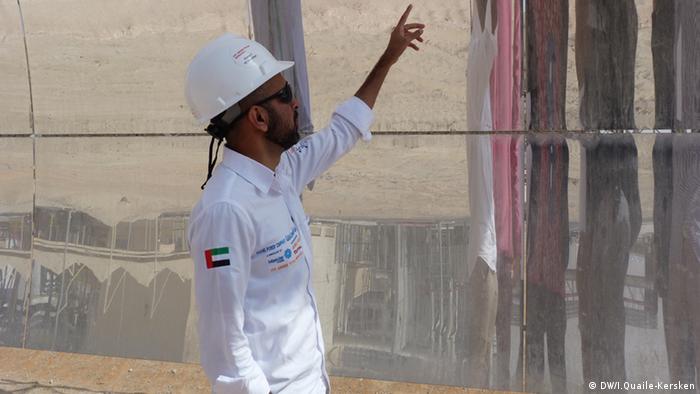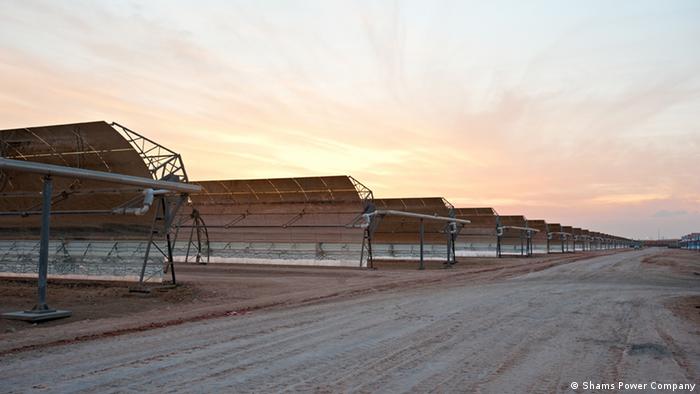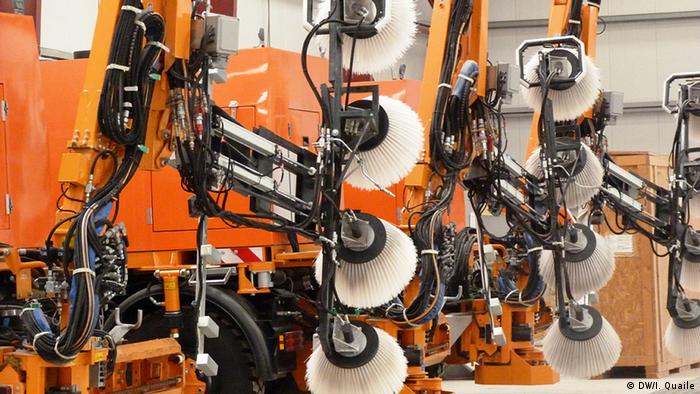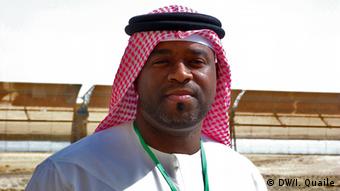The world's biggest thermal solar power plant has gone online in oil-rich Abu Dhabi. Shams 1 is the first plant of its kind in a desert region, providing power for thousands of homes.
Leaving the high-rise buildings of Abu Dhabi city behind us, we drive through the dust and sand of the desert. On both sides of the road, pylons and power-lines are a reminder that we are in a region with the world's biggest per-capita climate footprint. The residents of this hot, harsh climate use huge amounts of electricity to cool their homes and offices. Up to now, it has been provided by fossil fuels. That may be about to change.
One-hundred and twenty kilometers (75 miles) outside the capital, we reach the world's biggest concentrated solar power (CSP) plant - and the first in this part of the world to use such a system. As far as the eye can see, row on row of curved mirrors, used to concentrate solar thermal energy, shine out in the desert sun.
The plant covers an area of two and a half square kilometers, the equivalent of 285 football fields, says Bader Al Lamki, director of the Clean Energy Unit at Masdar. The Abu Dhabi company owns 60 percent of the plant. French energy giant Total and Spain's Abengoa each own 20 percent. Shams 1, which translates as "sun," has a capacity of 100 megawatts, enough to power 20,000 homes.
The plant covers an area of two and a half square kilometers, the equivalent of 285 football fields, says Bader Al Lamki, director of the Clean Energy Unit at Masdar. The Abu Dhabi company owns 60 percent of the plant. French energy giant Total and Spain's Abengoa each own 20 percent. Shams 1, which translates as "sun," has a capacity of 100 megawatts, enough to power 20,000 homes.
Masdar's "green energy" chief has swapped his traditional head covering for a safety helmet. We walk between the lines of giant parabolic troughs. Whereas photovoltaic systems convert sunlight directly into electricity, CSP makes use of the heat of the sun. The mirrors reflect the sunlight and concentrate it on an absorber tube filled with oil. The hot oil is used to create steam to run turbines. These then generate electricity.
Thermal solar vs. photovoltaics
CSP is a complex process and still relatively expensive. The desert plant cost $600 million (460 million euros) to build. Al Lamki avoids giving the cost of power per kilowatt-hour.
He admits that the costs for CSP have to come down. "The cost of photovoltaics dropped considerably in the last three years, becoming competitive with gas," he says. The price difference between the two solar technologies was not as marked when work started on Shams 1 three years ago.
CSP is a complex process and still relatively expensive. The desert plant cost $600 million (460 million euros) to build. Al Lamki avoids giving the cost of power per kilowatt-hour.
He admits that the costs for CSP have to come down. "The cost of photovoltaics dropped considerably in the last three years, becoming competitive with gas," he says. The price difference between the two solar technologies was not as marked when work started on Shams 1 three years ago.
Getting into solar energy is a wise move for Abu Dhabi, says Al Lamki: "We recognize that one day hydrocarbon resources will diminish, so we have started building solar capacity. When the last drop of oil is consumed, we are not going back to living in the desert, but will have an energy supply to continue our modern lifestyle."
By 2020, Abu Dhabi aims to provide seven percent of its electricity through renewables. The target is ambitious enough as a first step, Al Lamki says.
Challenges of the desert climate
From an outsider's point of view, solar power from the desert seems like an obvious option. However, Abdulaziz Al Obaidli, a German-educated process engineer at Shams 1, stresses there are problems to be overcome.
The atmosphere is very dusty, which means the solar radiation is scattered. "Sometimes we actually have less irradiation than the south of Spain, although we are close to the equator," Al Obaidli explains.
"The other problem is the cleaning. We have high humidity, so the dust accumulates on the mirrors."
Water is a precious resource in Abu Dhabi.
The atmosphere is very dusty, which means the solar radiation is scattered. "Sometimes we actually have less irradiation than the south of Spain, although we are close to the equator," Al Obaidli explains.
"The other problem is the cleaning. We have high humidity, so the dust accumulates on the mirrors."
Water is a precious resource in Abu Dhabi.
The engineer hopes a dry-cleaning method or protective coating method will at some point help reduce water use.
Water shortage also presents a problem for cooling the plant. Yousif Al Ali, the general manager of Shams, explains that is why the Abu Dhabi facility has a dry cooling facility. He points out the huge fans installed overhead.
No plant without gas
The air-cooling system means a slight drop in efficiency, says the plant manager. Nevertheless, he believes Shams 1 is the most efficient plant of its kind in the world. The reason is the addition of gas booster heaters. They increase the temperature of the oil which has been pre-heated by the sun, to bring it to the optimal running temperature.
The combination with gas is not in itself unusual with CSP plants, the experts stress. Normally, it is used to ensure energy is available 24/7.
The combination with gas is not in itself unusual with CSP plants, the experts stress. Normally, it is used to ensure energy is available 24/7.
Al Ali and Al Obaidli both worked on the construction of CSP plants in Spain, also partly funded by Masdar. Some of these use salt to store the solar heat and make it available at night. This is not essential at the Abu Dhabi plant, says Al Obaidli. Peak demand here is for air-conditioning around midday, when the plant runs at full capacity.
The International Renewable Energy Agency (IRENA), which has its headquarters in Abu Dhabi, confirms there is a trend towards solar energy in the Gulf region. Environment experts welcome it, including Jeffrey Sachs, director of the Earth Institute at Columbia University, New York. During a visit to Abu Dhabi he told DW mobilizing the region's huge solar potential could be a great economic opportunity for the region, in spite of the complex relationship with the oil industry.
The International Renewable Energy Agency (IRENA), which has its headquarters in Abu Dhabi, confirms there is a trend towards solar energy in the Gulf region. Environment experts welcome it, including Jeffrey Sachs, director of the Earth Institute at Columbia University, New York. During a visit to Abu Dhabi he told DW mobilizing the region's huge solar potential could be a great economic opportunity for the region, in spite of the complex relationship with the oil industry.
"Some of the countries realize that while their fossil fuel reserves, oil and gas in particular, are vast, they are not unlimited. They are saying we need a future that's beyond that," Sachs said.
The opening of Shams 1 could well be an important step in that direction. DW DE
The opening of Shams 1 could well be an important step in that direction. DW DE




No comments:
Post a Comment